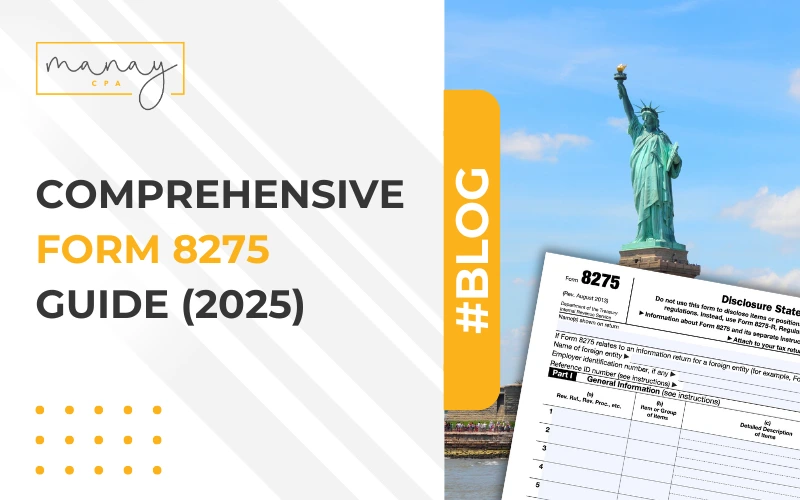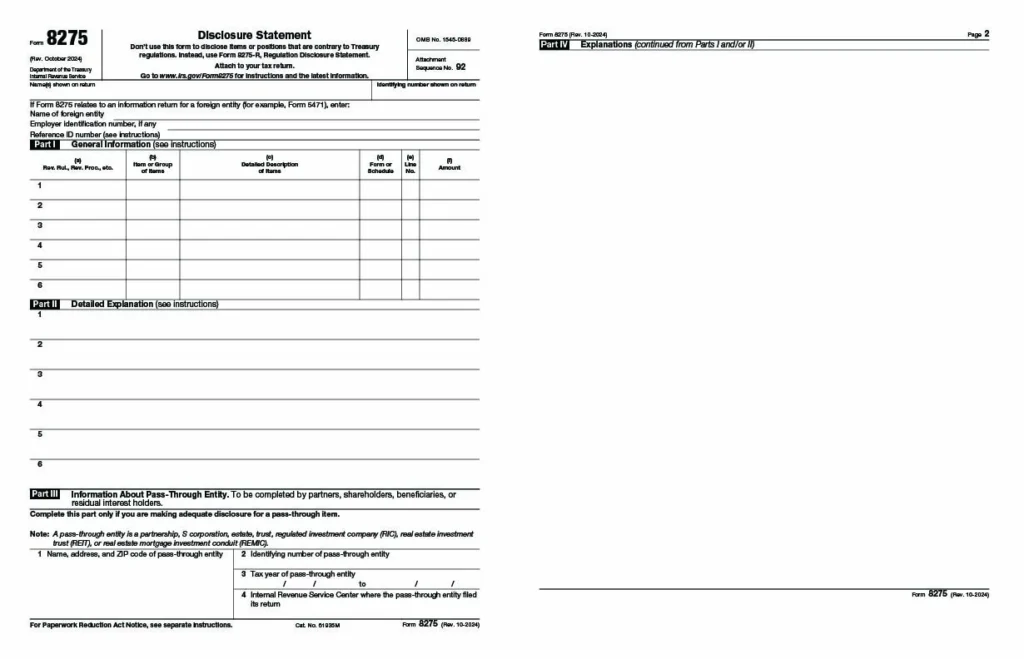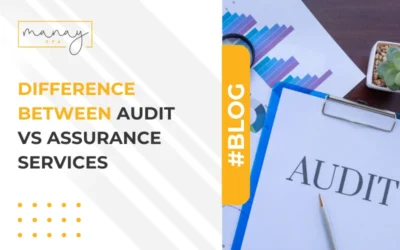Comprehensive Form 8275 Guide (2025)

Today, most taxpayers have multiple revenue streams. It’s common for individuals to have one or more jobs and a few side hustles to generate revenue. From a taxation standpoint, such streams are a nightmare as they require extensive accounting and disclosure. It’s even possible for the IRS to challenge certain provisions, or you may not have sufficient evidence for some deductions. To avoid penalties in such cases, there’s a generic form called Form 8275 that can be used to avoid penalties. This guide helps you better understand Form 8275 and how you can use it to your advantage.
Table of Contents
ToggleWhat is Form 8275?
Form 8275, also called the Disclosure Statement, is a form that taxpayers can use to disclose certain incomes or positions that are not covered by other forms. This form helps taxpayers avoid liabilities that the IRS can impose under Section 6662, which relates to underpayments of income tax.
Who Should File Form 8275?
Form 8275 can be filed by individuals, corporations, pass-through entities, and tax return preparers, if they are taking a position that is contrary to the existing regulations. It can also be filed if taxpayers are taking a specific stance on an ambiguous regulation. Therefore it is important for both individual tax preparation and business tax preparation.
Definitions for Form 8275
According to the IRS, taxpayers use Form 8275 to disclose items or provisions that are adequately disclosed on a tax return to avoid certain penalties. In general, this form offers protection against penalties related to understatement of taxes or disregarding the IRS rules, provided there is a reasonable basis.
“Reasonable Basis” in the Context of IRS Disclosures
“Reasonable basis” is also well-defined by the IRS. It means that there is at least a 20% chance for the taxpayer to defend the position when the IRS challenges it. Also, the tax position must be based on the authorities outlined in Regulations section 1.6662-4(d)(3)(iii).
Form 8275 vs. Form 8275-R: What’s the Difference?
There are two variations – Form 8275 and Form 8275-R. The first form is used when the taxpayer believes that the tax position is legally correct, even if it is not supported by clear regulations. On the other hand, if the taxpayer takes a stance that is against an existing regulation, Form 8275-R must be filed.
Form 8275 Deadline
Form 8275 is generally filed with the original tax return for the year in which the position is taken. However, in some cases, you may also file it with an amended return, as long as it qualifies under IRS rules. See Regulations sections 1.6662-4(f)(1) and 1.6664-2(c)(3) for details on when an amended return still provides protection.
Form 8275 and Form 8275 R Difference
As mentioned earlier, Form 8275-R must be filed when a tax position contradicts an existing regulation, while Form 8275 is used when the guidance is ambiguous for a given tax position.
When to Use Form 8275?
Form 8275 is used when;
- There is no clear IRS regulation for your tax position.
- You have taken a position based on a court case or informal guidance from the IRS.
- You are applying an IRS rule in a way that has neither been approved nor rejected by the IRS.
When to Use Form 8275-R?
On the other hand, Form 8275-R is used in the following scenarios:
- When your tax position challenges or contradicts an existing IRS regulation.
- You have legal grounds to argue against an existing regulation, in the form of a court decision or something that exists in the Constitution.
- You are knowingly applying a rule that contradicts an IRS regulation.
Key Legal and Strategic Differences
Form 8275-R represents a good-faith challenge to the existing regulation, while Form 8275 is simply a way to disclose items that are not adequately covered in other forms. In general, use Form 8275-R only when you have substantial evidence and a strong legal basis for disagreement. Also, filing a Form 8275-R will most likely result in an IRS challenge to the taxpayer’s position, so it must be used only when needed.
Step-by-Step Guide for Filling Out Form 8275
Filling out Form 8275 can be tricky, and hence, it is highly recommended that you engage an experienced tax preparer to handle this for you. Below are the steps involved:
Complete Parts I, II, and III Thoroughly
To start with, complete parts I, II, and III. On top of the page, you will find personal data, like name and identifying number, as entered in the original return. If you’re a foreign entity, provide your employer identification number and reference ID number.
Moving down, Part I is where your disclosures:
- Column a – If you are taking a position against an existing rule, enter the provision or ruling.
- Column b – Identify the item by name. If it’s from a pass-through entity, mention that as well.
- Column c – Enter the complete description of the item. For example, if you’ve entered the item as “Entertainment expenses” in column B, you must specify which expense in this column. Examples can be “dinner with the client”, “theater expenses”, etc.
- Column d – Enter the form number or schedule.
- Column e – Enter the line number of the form mentioned in column d.
- Column f – Fill the amount in this column.
Use Part II to provide a detailed explanation of each item entered in Part I. This description must provide the context for the IRS, so its officers can evaluate whether the item is reasonable.
Part III is only for partners, shareholders, beneficiaries, and residual interest holders of pass-through entities. Enter the name and address of the entity in row 1, the identifying number in row 2, the tax year in row 3, and the location where the return was filed in row 4. You can get all this information in Schedule K-1.
Disclosing Positions Involving Foreign Entities
If you want to disclose positions for foreign entities, you must file a separate Form 8275 for each foreign entity. It must include details of any items related to foreign financial assets. Under IRC §6662(j), understatements attributable to undisclosed foreign financial assets may be subject to a 40% accuracy-related penalty.
Submitting Form 8275 with Your Return
You must attach Form 8275 to your original tax return. Never mail or file it separately. If you are e-filing the return, check if your tax software supports the process of attaching Form 8275. Similarly, check with your tax preparer if this form has been filed with your return.
Common Mistakes to Avoid Filling Out Form 8275
Given the complexity of filling out Form 8275, it can lead to mistakes. Some common pitfalls to avoid are:
- Not filing it with your original return.
- Incomplete explanations in your form.
- Adding the wrong regulation or ruling.
- Filing Form 8275 instead of 8275-R when you want to challenge an existing provision.
- Entering wrong data.
Does Filing Form 8275 Increase Your Risk of an Audit?
Filing 8275 does not increase your risk of an audit because it reflects transparency and good faith. Though specific provisions or issues that you mention may draw a closer look, it does not directly lead to an audit.
What Happens If You Don’t Disclose a Questionable Position?
If you don’t disclose a questionable position, you will find it harder to defend your stance. Also, it can lead to a liability of 20% of the underpaid amount in the form of an accuracy-related penalty, along with interest on the underpaid amount. For individuals, a ‘substantial understatement’ means the greater of 10% of the correct tax or $5,000. For corporations (other than an S corporation or a personal holding company, as defined in section 542), the threshold is the greater of 10% of the correct tax or $10,000
Audit Season: How Form 8275 Helps Prepare Your Defense
A well-prepared Form 8275 can be a great defense in the event of an IRS audit because it demonstrates transparency and good faith on the part of the taxpayer. It also shows that you have a reasonable basis and your only intent was not to underpay or underdisclose your earnings. All these can help you earn a good settlement even if your tax position was not accepted by the IRS.
IRS Penalty Relief: How Disclosure Enhances Negotiation Options
The IRS will not levy the 20% accuracy-related penalty on any item, provided you show that there was a reasonable cause and you acted in good faith. Even if your position was not accepted, the IRS may be open to a reasonable settlement due to your efforts to be transparent.
Strategic Use Cases for Form 8275
Form 8275 must not be used in every situation, as this can lead to a 20% accuracy-related penalty. There are specific strategic use cases that can provide relief when you file Form 8275.
When Can Form 8275 Save You?
Form 8275 can come in handy in the following scenarios:
- Taking a deduction where the IRS rules are vague.
- Reporting an income that doesn’t fit into any category specified by the IRS.
- Claims credits on ambiguous definitions.
Real-World Scenarios: How Can Form 8275 Save a Taxpayer
To better understand how Form 8275 can save a taxpayer, here are a few real-world scenarios:
- A startup company undertakes R&D activities that don’t fully fall under IRC Section 174.
- A real-estate investor claims QBI deductions under safe harbor rules for a property that is on the borderline passive.
- There are no formal regulations, though the IRS has provided informal guidance on a specific provision.
In all the above cases, filing Form 8275 can protect the taxpayer.
How Can Manay CPA Help You with Form 8275?
Form 8275 is complex and requires an in-depth understanding of the IRS regulations. This is where experienced professionals at Manay CPA come in. Here are some ways in which they can help with Form 8275.
Experienced CPAs for Filling Out
ManayCPA’s tax preparers can review your original return and tax positions. Based on past rulings and their experiences, they determine if you have a reasonable basis for a specific tax position, and can advise you accordingly.
Helping with Tax Returns and Deadlines
ManayCPA can help prepare Form 8275 based on the tax position discussed with you. Additionally, they will file it with the original return to ensure that you face no difficulties or penalties due to delayed filing.
IRS Representation
In case of audits and to defend your position laid out in Form 8275, ManayCPA’s experts will represent you. They will provide documentation and evidence where necessary, and can also successfully negotiate with the IRS on your behalf.
Free Consultation (CTA)
To learn more about how ManayCPA can help, start with a free consultation. They will assess your position and explain how to proceed safely.
✅ Frequently Asked Questions (FAQ)
Do I need to file Form 8275 if my tax position isn’t clearly supported by IRS regulations?
Yes, if you have a reasonable basis for a certain position that is not backed by clear IRS regulations.
Can Form 8275 help me avoid IRS penalties for aggressive tax positions?
Yes, filing Form 8275 reflects transparency and good faith, and thus can help avoid high penalties, even if the IRS does not agree with your position.
Is it better to use Form 8275 or Form 8275-R when challenging IRS regulations?
Form 8275 is the better of the two when you are taking a tax position for an ambiguous rule. However, go for Form 8275-R when you are challenging an existing IRS regulation.
Can businesses file Form 8275, or is it just for individuals?
Both individuals and businesses can file Form 8275.
Will filing Form 8275 trigger a red flag for the IRS or lead to an audit?
Not necessarily, as disclosure reflects good faith on the part of the taxpayer. It may even reduce potential disputes and fines.
What qualifies as a “reasonable basis” for filing Form 8275?
A reasonable basis is when there is at least a 20% chance of success for a tax position, based on past court rulings and IRS guidance.
Can I amend my return to include Form 8275 if I forgot to file it initially?
Yes, you can amend your return to include Form 8275, provided it meets the 1.6662-4(f)(1) and 1.6664-2(c)(3) sections. It’s always better to file Form 8275 with your original return.
Is legal or CPA support required to file Form 8275 correctly?
While it is not mandatory, hiring a CPA is highly recommended. An experienced CPA can help write strong explanations, cite relevant rulings, and even represent you in an IRS audit.
How long do I have to file Form 8275?
It must be filed with the original return.
Summarize the blog with Artificial Intelligence (AI):
Published on: 21 August 2025
Last updated on: 21 August 2025
Manay CPA is a reputable, full-service CPA firm based in Atlanta, Georgia. Founded in 2001, we provide comprehensive accounting and tax solutions to individuals and businesses across all 50 states.






